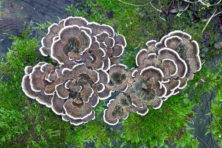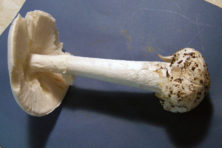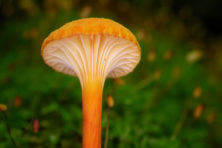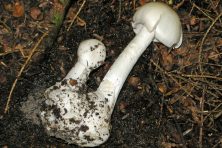DOOR TO NATURE: Mushroom Season
- Share
- Tweet
- Pin
- Share

This year’s very dry spring yielded only two morel mushrooms in my favorite hunting area. I didn’t even look for any chanterelles in July. A normal good season for these early edible mushrooms would have a winter of heavy snow and a spring with warm weather and lots of rain. None of these events occurred in 2023.
The three months of April, May and June brought less than four-and-a-half inches of rain. In fact, the first week of May was very wet, then from May 8 to July 5, I got less than a half inch of rain! The longer it stays dry, the more heavy rain is needed to bring the soil mycelium (the actual vegetative plant) out of dormancy. Then, more substantial rains will help the actual mushrooms, the “fruiting bodies,” develop.
Mushrooms are the reproductive part of the fungus, like the apple on a tree. However, fungi don’t have seeds or chlorophyll. They grow into mycelium from the microscopic spores that are released from the mushrooms. Since most mushrooms are 80 to 90% water, you can understand what a two-month drought will do to the mycelium: it becomes dormant.
Now, as I write this at the end of August, my wishes have come to fruition. July gave me three inches of rain and August has brought over five inches. I led my first of 19 scheduled mushroom hikes on Aug. 11 at The Ridges Sanctuary and found three new species for that property. Two of them were new species for my Door County list, bringing that total to 605.
People sometimes ask me to lead a mushroom foray in spring. I usually decline, knowing that so few mushrooms are growing at that time. The true morels are found in late April and May, but not many other species are seen. Most types have their own season of fruiting and the majority appear in summer and fall as the regular growing season for plants and trees begins to wind down.
The experienced hunters know that the true edible morel does not appear in autumn. Many of the good edibles seem to develop from mid-summer – like the golden chanterelle – and later into autumn. Some species don’t show up until the first frost.
I remember hearing about the massive volcanic eruption of Mount Pinatubo in the Philippines in June of 1991. Experts said it forced so much debris into the higher atmosphere that it might affect the world’s weather for the next several years. It was June the following year that Roy and I worked to build a tall wire fence around our large vegetable garden to keep deer and other animals out. We finished the job the day before Father’s Day. There was a killing frost that night and we lost about 60% of the tender crops.
Two weeks later, after a couple of heavy rains, I was finding shaggy mane and honey cap mushrooms. They normally don’t grow until September after a frost. That incident helped to prove my theory about how the weather can affect mushroom growth.
There are numerous good, edible mushrooms that begin to grow in late summer after substantial rains. The golden chanterelle, collected by many people, are winding down their season. They can be found from mid-July into September, but the quality deteriorates at the end of their season.
One of the favored mushrooms that Roy and his father would pick is called the honey cap, Armillaria mellea, a somewhat difficult species to identify at first. It is poisonous if eaten raw. In fact, all mushrooms should be cooked before eaten.
The honey cap grows either on trees or at the base of them. It has a brown convex cap with slightly raised scales and an incurved margin, but can become pale brown, smooth and flat as it ages. Many species may change colors and shapes as they age.
Another good mushroom to eat is the aborted Entoloma, Entoloma abortivum. It appears as a round white ball, sometimes near the normal mushroom, but has no gills, cap or stem. All other Entoloma species are poisonous, but this one is good to eat when fresh and solid.
If you want to eat wild mushrooms, always learn those that are poisonous in your area. Some will cause you to vomit within a couple hours, others may kill your red blood cells, some are hallucinogenic, and the worst one destroys your liver and kidneys. That one is called Amanita bisporigera, and the symptoms don’t occur until six to 10 hours after ingesting them.
Be very wise in your wild mushroom meals. Most poisonings are due to ignorance and carelessness!
Wild mushrooms continue to appear as long as we get enough rain and the temperature stays above freezing during the day. Once the freezing remains all night and all day, the mushroom season is over.




